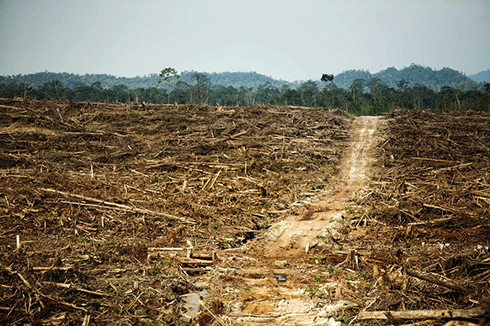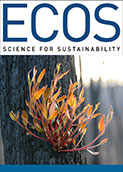
|
Published: 18 August 2014
Shifting lands: how international trade is transforming global biodiversity
Take a look at the food in your fridge, at the clothes you are wearing or even the roof over your head; chances are you are looking at products from all over the world.

|
|
Former forest in West Kalimantan cleared for palm oil: the environments of Brazil and Indonesia have absorbed the impact of global demand for agricultural products like soy bean and palm oil. Between 2000 and 2005, deforestation in those two nations made up 64 per cent of the global loss of old-growth tropical forests.. Credit: Rainforest Action Network under CC BY-NC 2.0
|
Very few nations can meet their demand for materials from domestic resources alone and so most depend on international trade. The amount of raw materials crossing national borders has increased eightfold in the past five decades, but what does this mean for our landscapes and biodiversity?
Taking land to market: land displacement
Global trade has led to an increase in the distance between where a product is produced and where it is consumed.
For products that rely on land, such as agriculture and forestry, an outcome of spatial separation between production and consumption is land displacement. Land displacement occurs when the resources consumed by people in one nation or region are produced on land in another.
We can quantify land displacement to reveal the amount of land needed to satisfy a nation’s consumption, and then follow supply chains to show where that land comes from. When researchers do this, the picture that emerges is one of a first-world vacuum, as the land from the poor is sucked into the rich.

|
|
Land used for export production (in Mha). The map highlights total land, cropland, grazing land and forest land displaced through export production. The thickness of the arrows and numbers next to the arrows represent the amount of land used as inputs for the production of imported and exported goods. Credit: Map and legend are from Yu et al. 2013.
|
The figure above shows that there is an overall trend for land to be displaced from poor to rich nations. For instance, the US, EU and Japan appropriate (i.e. displace from other nations) 33 per cent, <50 per cent (unspecified), and 92 per cent of their land-use, respectively. In other words, 92 per cent of the land used to feed, house, and clothe people in Japan occurs in areas outside of Japan.
Further, despite the food security issues of many developing nations, land used for food production (e.g. cropland) in poorer nations tends to be displaced to wealthier nations.
Land displacement and environmental accounts
These findings are challenging a long-held view of a ‘decoupling’ between economic growth and environmental degradation. This view proposes that as economies mature, they become more efficient in their resource use and implement greater environmental protections, thereby reducing environmental degradation.
Instead, research shows that the consumption of land and other materials is roughly proportional to per capita national income: the more money you have, the more resources you consume. For instance, Australians consume more resources per capita than citizens of any other nation.
The illusion of decoupling is brought by the tendency of developed economies to redistribute environmental harm by importing commodities produced by environmentally damaging industries. This improves their environmental performance within their national boundaries, but at the expense of other nations.
Illusory forest transitions
Studies of forest cover provide one of the clearest examples of land displacement leading to illusory environmental improvements.
Forests are often cleared for their timber or to make way for agricultural land. In recent decades, some nations have seen ‘forest transitions’: mass reforestation, where land previously used for agriculture has reverted to forest. This is seen as a win for biodiversity.
However, reforestation is often accompanied by an increase in imports of timber or agricultural products, suggesting that reforestation in one nation depends on deforestation in others, a process called ‘leakage’.
For instance, France has seen much reforestation in recent decades. However, this has been accompanied by an increase in land-intensive imports such that their net displacement of land is much greater than the area of reforested land. Similarly, the US displaces around 60 Mha of forestland from Russia, China, SE Asia and Africa – an area about the size of Madagascar – allowing the US to maintain higher national forest cover than it otherwise would.
On the other hand, Brazil and Indonesia have tended to absorb the global demand for agricultural products, particularly soy beans and palm oil. Between 2000 and 2005, deforestation in those two nations made up 64 per cent of the global loss of old-growth tropical forests..
Biodiversity displacement
Given that land-use change is the biggest cause of biodiversity decline globally, what does land displacement mean for biodiversity?
Lenzen et al. (2012) measured threats to biodiversity embodied in commodities to demonstrate how such threats are displaced from nation to nation.
They found developed nations tended to import commodities implicated in biodiversity threats, whereas developing nations tended to export them. This is partly due to developed nations often having stronger domestic policies aimed at protecting biodiversity, thereby restricting the local production of ecologically harmful commodities.
Ecological harm is effectively displaced to developing nations with less stringent environmental protections. Overall, 44 per cent of the biodiversity threats linked to resource use by developed nations come from products produced in other nations. For example, Germany imports commodities linked to nearly 400 species threats, whereas Malaysia – a developing nation – exports nearly 300 of such commodities.
Who is responsible?
Global trade raises vexing questions about who should be held responsible for environmental degradation linked to traded goods. In general, there are three potential candidates: the producer, the trader, and the consumer, and some responsibility must lie with all three.
One team of researchers has outlined how each of these groups can be held more accountable for the environmental harm embodied in traded goods.
For producers, particularly those corporations based in the developed world but extracting resources from developing nations, governments could extend domestic environmental policies to corporation working in distant markets.
For traders, there are international agreements and conventions on ethical trading that could be extended to commodities that imperil biodiversity, such as palm oil.
Finally, for consumers, labelling systems that detail ecological harm embodied in products can help consumers chose less harmful products.
Each of these ideas has strengths and weaknesses, but laying some responsibility on each party is a good starting point for thinking about the ethics of habitat degradation in a globalised marketplace.
Dr Dale Nimmo is an Alfred Deakin Postdoctoral Research Fellow at Deakin University, Melbourne. His current research focus is on conserving biodiversity in human-dominated landscapes.



